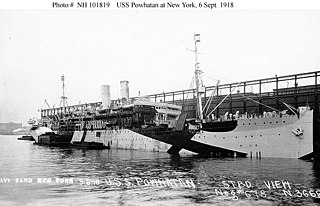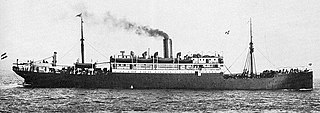
Kaiser Wilhelm der Grosse was a German transatlantic ocean liner in service from 1897 to 1914, when she was scuttled in battle. She was the largest ship in the world for a time, and held the Blue Riband until Cunard Line’s RMS Lusitania entered service in 1907. The vessel’s career was relatively uneventful, despite a refit in 1913.

SS Imperator was a German ocean liner built for the Hamburg America Line, launched in 1912. At the time of her completion in June 1913, she was the largest passenger ship in the world, surpassing the new White Star liner Olympic.
Norddeutscher Lloyd was a German shipping company. It was founded by Hermann Henrich Meier and Eduard Crüsemann in Bremen on 20 February 1857. It developed into one of the most important German shipping companies of the late 19th and early 20th centuries, and was instrumental in the economic development of Bremen and Bremerhaven. On 1 September 1970, the company merged with Hamburg America Line (HAPAG) to form Hapag-Lloyd AG.
Aktien-Gesellschaft Vulcan Stettin was a German shipbuilding and locomotive building company. Founded in 1851, it was located near the former eastern German city of Stettin, today Polish Szczecin. Because of the limited facilities in Stettin, in 1907 an additional yard was built in Hamburg. The now named Vulcan-Werke Hamburg und Stettin Actiengesellschaft constructed some of the most famous civilian German ships and it played a significant role in both World Wars, building warships for the Kaiserliche Marine and the Kriegsmarine later.

Kronprinz Wilhelm was a German ocean liner built for Norddeutscher Lloyd, a shipping company now part of Hapag-Lloyd, by the AG Vulcan shipyard in Stettin, Germany, in 1901. She was named after Crown Prince Wilhelm, son of the German Emperor Wilhelm II, and was a sister ship of SS Kaiser Wilhelm der Grosse.

SS Kronprinzessin Cecilie was an ocean liner built in Stettin, Germany in 1906 for North German Lloyd that had the largest steam reciprocating machinery ever fitted in a ship. The last of four ships of the Kaiser class, she was also the last German ship to have been built with four funnels. She was engaged in transatlantic service between her home port of Bremen and New York until the outbreak of World War I.

SS Columbus was a German ocean liner laid down before the start of World War I.

USS DeKalb (ID-3010) was the German mail ship Prinz Eitel Friedrich that served during the early part of the First World War as an auxiliary cruiser (Hilfkreuzer) in the Imperial German Navy and later after the US entry into the war, as a US Navy troop ship. Post war she returned to civilian service as the US transatlantic liner SS Mount Clay.

SS George Washington was an ocean liner built in 1908 for the Bremen-based North German Lloyd and was named after George Washington, the first President of the United States. The ship was also known as USS George Washington (ID-3018) and USAT George Washington in service of the United States Navy and United States Army, respectively, during World War I. In the interwar period, she reverted to her original name of SS George Washington. During World War II, the ship was known as both USAT George Washington and, briefly, as USS Catlin (AP-19), in a short, second stint in the U.S. Navy.

Prinzessin Victoria Luise was the World's first purpose-built cruise ship. She was built in Germany, and launched in 1900 for Hamburg America Line (HAPAG).

SS Prinz Eitel Friedrich was a German passenger liner which saw service in the First World War as an auxiliary cruiser of the Imperial German Navy. Though largely overlooked, Prinz Eitel Friedrich was, after SS Kronprinz Wilhelm, the most successful of Germany’s first wave of auxiliary cruisers. She was able to remain at large for seven months, from August 1914 to March 1915, and sank 11 ships, for a total tonnage of 33,000 GRT.

SS Prinz Friedrich Wilhelm was an ocean liner for North German Lloyd (NDL) from her launch in 1907 until the end of World War I. After the war, she briefly served as USS Prinz Friedrich Wilhelm (ID-4063) for the United States Navy returning American troops from France. The vessel was first chartered—and later purchased outright—by Canadian Pacific Steamships (CP) and operated under the names Empress of China, Empress of India, Montlaurier, Monteith, and Montnairn. She was scrapped in 1929.

USS Powhatan (ID–3013) was a transport ship for the United States Navy during World War I. She was originally Hamburg, a Barbarossa-class ocean liner built in 1899 by AG Vulkan of Stettin, Germany, for the Hamburg America Line. At the outset of World War I the ship was interned by the United States.

USS General W. C. Gorgas (ID-1365) was a cargo liner that was launched in Germany in 1902 as Prinz Sigismund for the Hamburg America Line. In 1917 the USA seized her and renamed her General W. C. Gorgas. In 1945 she was transferred to the Soviet Union, which renamed her Mikhail Lomonosov. She was scrapped in March 1958.

The Kaiser-class ocean liners or Kaiserklasse refer to four transatlantic ocean liners of the Norddeutscher Lloyd, a German shipping company. Built by the AG Vulcan Stettin between 1897 and 1907, these ships were designed to be among the largest and best appointed liners of their day. These four ships, two of which held the prestigious Blue Riband, were known as the "four flyers" and all proved to be popular with wealthy transatlantic travellers. They also took great advantage of the masses of emigrants who wished to leave Europe.

SS Prinz Adalbert was a twin-screw cargo liner that was launched in Germany in 1902 for Hamburg America Line (HAPAG). In 1914 the United Kingdom Admiralty seized her and renamed her Prince. In 1916 she was renamed Princetown. On 1917 she was transferred to the Compagnie de Navigation Sud-Atlantique and renamed Alesia. Later in 1917 a U-boat sank her.

SS Burdigala was an ocean liner that sailed the Atlantic Ocean from 1898 until World War I. The ship was built as the Kaiser Friedrich in 1898 for Norddeutscher Lloyd (NDL), a German shipping line. Designed to break the speed record for a transatlantic liner and thereby win the Blue Riband, the Kaiser Friedrich never achieved the necessary speeds. After a short career with NDL and an equally short period of service with NDL's main German competitor, the Hamburg-Amerikanische Packetfahrt-Aktien-Gesellschaft, the ship was mothballed for a decade. After being sold to the French shipping line Compagnie de Navigation Sud-Atlantique, it re-entered service as SS Burdigala. In 1916, while en route from Thessaloniki to Toulon, the liner struck a mine laid by the German U-boat U-73 in the Aegean Sea and sank near Kea, Greece.

SS Otsego was a cargo liner that was launched in Germany in 1901 as Prinz Eitel Friedrich. The USA seized her in 1917 and renamed her Otsego. In 1919 she served in the United States Navy as USS Otsego (ID-1628). She spent the 1920s and 30s in merchant service as Otsego. In 1941 she became the United States Army ship USAT Otsego. In 1945 she was transferred to the Soviet Union, which renamed her Ural. In 1947 she may have been renamed Dolinsk. She was either hulked or scrapped in 1955.

SS Prinz Oskar was a twin-screw cargo liner that was launched in Germany in 1902 for Hamburg America Line (HAPAG). She served various transatlantic routes between Europe and the Americas until the First World War began.

SS Prinz August Wilhelm was a Hamburg America Line (HAPAG) cargo liner that was launched in Germany in 1902 and scuttled in Colombia in 1918. Her original route was between Hamburg and Mexico. From 1906 she served routes between New York and the Caribbean.






















